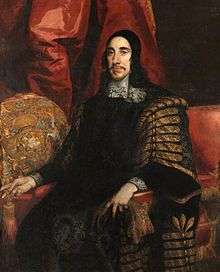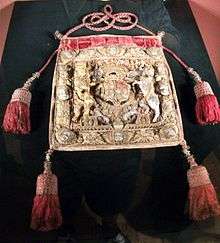Sir Orlando Bridgeman, 1st Baronet, of Great Lever
| Orlando Bridgeman | |
|---|---|
 Sir Orlando Bridgeman | |
| Born | 30 January 1606 |
| Died | 25 June 1674 (aged 68) |
| Occupation | English politician |

Sir Orlando Bridgeman, 1st Baronet, SL (30 January 1606 – 25 June 1674) was an English common law jurist, lawyer, and politician who sat in the House of Commons from 1640 to 1642. He supported the Royalist cause in the English Civil War.
Life
Bridgeman was the son of John Bridgeman, Bishop of Chester, and his wife Elizabeth Helyar, daughter of Reverend William Helyar. He was educated Queens' College, Cambridge and graduated with a Bachelor of Arts in 1624.[1] In the same year, Bridgeman became a Fellow of Magdalene College, Cambridge and was called to the Bar at the Inner Temple. He worked as barrister until 1632, becoming Vice-Chamberlain of Chester in 1638. In 1640, he was appointed Attorney of the Court of Wards in 1640, and Solicitor-General to Charles, the Prince of Wales.
In April 1640, Bridgeman was elected Member of Parliament for Wigan in the Short Parliament. He was re-elected MP for Wigan for the Long Parliament in November 1640.[2] He rallied to the royal cause and in 1642 assisted Lord Strange at Chester against the parliamentary forces. As a result, he was disabled from sitting in parliament on 29 August 1642.[3] He was knighted by the King in 1643. From 1644 to 1646, Bridgeman was Custos Rotulorum of Cheshire. In 1645, he was Commissioner at the Treaty of Uxbridge. He compounded for his delinquency in 1646.
On 30 May 1660, Bridgeman was made Serjeant-at-Law, and two days later Lord Chief Baron of the Exchequer. The following week, on 7 June 1660, he was created a Baronet, of Great Lever, in the County of Lancaster. From 1660 to 1668, Bridgeman was Chief Justice of the Court of Common Pleas, and from 1667 to 1672 Lord Keeper of the Great Seal, resigning because he refused to apply the Great Seal to the Royal Declaration of Indulgence, which he regarded as too generous to Catholics. In 1668, he was a member of the New England Company. In his final years, Bridgeman appointed metaphysical poet, theologian, and priest Thomas Traherne (c. 1637 – 1674) as his private chaplain at Teddington and supported the publication of his writings. Bridgeman died aged 65 in Teddington, Middlesex and was buried there.
Bridgeman was highly regarded in his time for his participation in the trial of the regicides of King Charles I in 1660, and for devising complex legal instruments for the conveyance of estates in land. Among Bridgeman's most enduring inventions was a device for the 22nd Earl of Arundel, which led to the creation in the Duke of Norfolk's Case, 3 Ch. Ca. 1, 22. Eng. Rep. 931 (Ch. 1681), of the Rule Against Perpetuities. Following the Great Fire of London he was one of the judges appointed to resolve disputes about property arising from the fire.
Family
Bridgeman married twice, firstly Judith Kynaston, daughter of John Kynaston, on 30 January 1627 or 1628. They had two children:
- Mary Bridgeman, married, firstly Sir Edward Morgan, married secondly Richard Hanbury
- Sir John Bridgeman, 2nd Baronet (1631–1710)
Secondly he married Dorothy Saunders, daughter of John Saunders. They had three children:
- Sir Francis Bridgeman, married Susan Barker, daughter of Sir Richard Barker
- Sir Orlando Bridgeman, 1st Baronet, of Ridley (died 1701)
- Charlotte Bridgeman (died 1694), married Sir Thomas Myddelton, 2nd Baronet in 1677
See also
References
- ↑ "Bridgman, Orlando (BRGN619O)". A Cambridge Alumni Database. University of Cambridge.
- ↑ Willis, Browne (1750). Notitia Parliamentaria, Part II: A Series or Lists of the Representatives in the several Parliaments held from the Reformation 1541, to the Restoration 1660 ... London. pp. 229–239.
- ↑ The parliamentary or constitutional history of England;: being a faithful account of all the most remarkable transactions in Parliament, from the earliest times. Collected from the journals of both Houses, the records, ..., Volume 9
- "thePeerage". Retrieved 2006-11-29.
- J. Dukeminier; J. Krier (2006). Property, Sixth Edition. Aspen. p. 241, footnote.
External links
- Portraits of Orlando Bridgeman at the National Portrait Gallery, London

- The Twickenham Museum: Orlando Bridgeman
- The Diary of Samuel Pepys: Wednesday 10 October 1660
| Parliament of England | ||
|---|---|---|
| Vacant Parliament suspended Title last held by Edward Bridgeman |
Member of Parliament for Wigan 1640–1642 With: Alexander Rigby |
Succeeded by Alexander Rigby |
| Political offices | ||
| Preceded by Sir George Booth |
Custos Rotulorum of Cheshire 1644–1646 |
Vacant Title next held by The Lord Delamer |
| Preceded by The Earl of Clarendon |
Lord Keeper of the Great Seal 1667–1672 |
Succeeded by The Earl of Shaftesbury |
| Legal offices | ||
| Preceded by John Wilde |
Lord Chief Baron of the Exchequer 1660 |
Succeeded by Matthew Hale |
| Preceded by Oliver St John |
Chief Justice of the Common Pleas 1660–1667 |
Succeeded by Sir John Vaughan |
| Baronetage of England | ||
| New creation | Baronet (of Great Lever) 1660–1674 |
Succeeded by John Bridgeman |